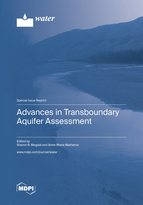Advances in Transboundary Aquifer Assessment
A special issue of Water (ISSN 2073-4441).
Deadline for manuscript submissions: closed (1 July 2021) | Viewed by 53283
Special Issue Editors
Interests: comparative evaluation of water management; policy and governance in water-scarce regions; groundwater recharge; and transboundary aquifer assessment
Special Issues, Collections and Topics in MDPI journals
Special Issue Information
Dear Colleagues,
The need to feed and support the world’s growing population has placed a spotlight on the world’s underground freshwater resources. As groundwater use increases globally, there is growing recognition that critical to sound groundwater management is a detailed understanding of aquifer conditions. Of special consideration is aquifer assessment in a transboundary setting, where cooperation of multiple jurisdictions, sometimes with different languages and cultures, is required. The paucity of formal agreements governing the sharing of groundwater across borders suggests there is an opportunity to contribute to the advancement of the science as well as management of transboundary aquifers through sharing approaches to and results of transboundary aquifer assessment efforts. This Special Issue of Water invites papers reporting on transboundary aquifer assessment research. The guest editors invite papers that describe aquifers, groundwater availability and quality, and water use. Integrated studies, including modeling, that incorporate various aspects of the hydrologic system and/or socioeconomic conditions are welcomed. In addition, the Guest Editors invite papers analyzing relevant institutional issues and mechanisms for cooperation, which could serve as the foundation for collaboration extending to management of transboundary groundwater. We encourage authors to share both challenges and successes associated with working across jurisdictional borders, whether they be borders between sovereign nations, as well as between different states or jurisdictions within a country. Papers that address cooperative mechanisms for transboundary aquifer assessment are also invited.
Prof. Sharon B. Megdal
Dr. Anne-Marie Matherne
Guest Editors
Manuscript Submission Information
Manuscripts should be submitted online at www.mdpi.com by registering and logging in to this website. Once you are registered, click here to go to the submission form. Manuscripts can be submitted until the deadline. All submissions that pass pre-check are peer-reviewed. Accepted papers will be published continuously in the journal (as soon as accepted) and will be listed together on the special issue website. Research articles, review articles as well as short communications are invited. For planned papers, a title and short abstract (about 100 words) can be sent to the Editorial Office for announcement on this website.
Submitted manuscripts should not have been published previously, nor be under consideration for publication elsewhere (except conference proceedings papers). All manuscripts are thoroughly refereed through a single-blind peer-review process. A guide for authors and other relevant information for submission of manuscripts is available on the Instructions for Authors page. Water is an international peer-reviewed open access semimonthly journal published by MDPI.
Please visit the Instructions for Authors page before submitting a manuscript. The Article Processing Charge (APC) for publication in this open access journal is 2600 CHF (Swiss Francs). Submitted papers should be well formatted and use good English. Authors may use MDPI's English editing service prior to publication or during author revisions.
Keywords
- transboundary aquifer assessment
- aquifer conditions
- groundwater
- hydrologic modeling
- cooperative mechanisms







